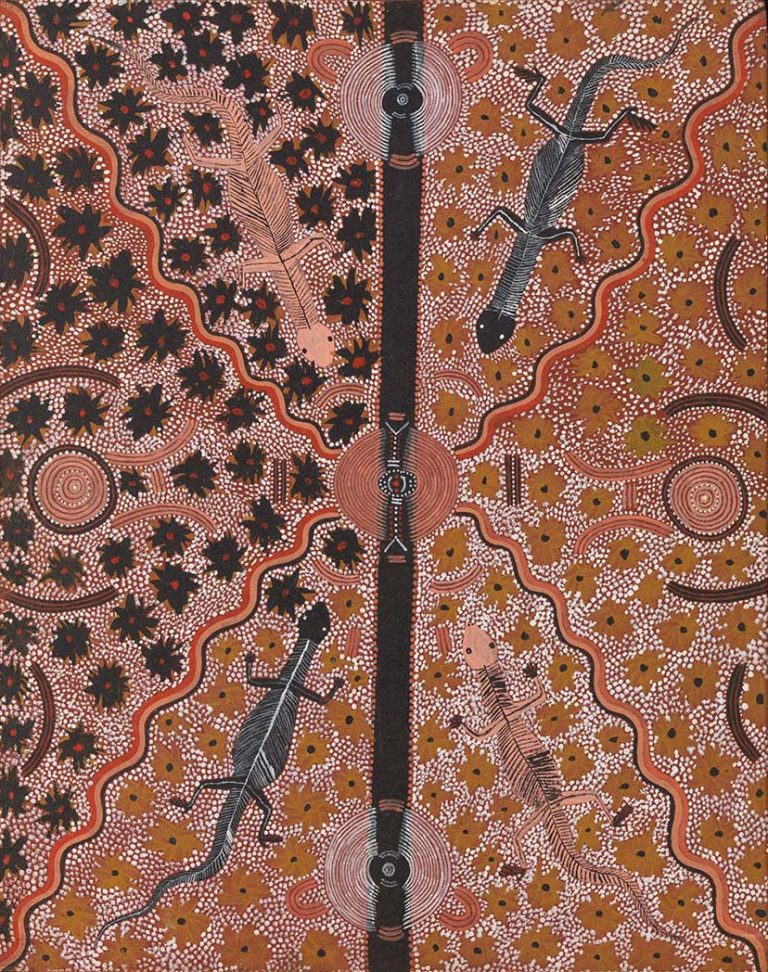We acknowledge the Traditional Owners of the land on which the Queensland Art Gallery | Gallery of Modern Art stands and recognise the creative contribution First Australians make to the art and culture of this country.

Kaapa Mbitjana Tjampitjinpa / Anmatyerre/Arrernte people / Australia c.1925–89 / Goanna story c.1973–74 / Synthetic polymer paint on board / 76 x 60.2cm / Purchased 1996 with funds from National Australia Bank Limited through the Queensland Art Gallery Foundation / Collection: Queensland Art Gallery | Gallery of Modern Art / © Estate of Kaapa Mbitjana Tjampitjinpa. Licensed by Aboriginal Artists Agency Ltd.
Kaapa Mbitjana TjampitjinpaGoanna Story c.1973–1974
On Display: QAG, Gallery 13
From the late 1950s Kaapa Mbitjana Tjampitjinpa was based in Papunya, north-west of Hermannsburg, in the Northern Territory. According to Ian McLean, there were three schools of art at Papunya: the best known, practiced by the Arrernte, painted in Albert Namatjira’s watercolour style (Hermannsburg School); another, practiced by the Pintupi people, made traditional artefacts; and a third group of artists, of whom Tjampitjinpa was the chief practitioner, were making hybrid wood carvings.1
The Western Desert movement emerged from this dynamic third school. Goanna Story is an interesting combination of traditional imagery with realistic depictions of the goannas. The Goanna is one of Kaapa Mbitjana Tjampitjinpa’s Dreamings. Here, he has depicted them as moving towards a particular site, possibly a waterhole. The images of flowers may also indicate a story relating to water, and how it transforms the desert.
Endnotes:
1. Ian McLean, Rattling Spears: A History of Indigenous Australian Art, Reaktion Books, London, 2016, p.126.
Kaapa Mbitjana Tjampitjinpa was born around 1925 on Napperby Station, north-west of Alice Springs (Mpwarntwe) in the Northern Territory. He worked as a stockman at Mount Riddock Station, south of Urapuntja (formally known as Utopia), before moving to Papunya in the late 1950s/early 1960s. He was a member of the Anmatyerre/Arrernte people and an elder of the Haasts Bluff (Ulumpawarru) region.
Tjampitjinpa regularly painted the Owl, Shield, Witchetty Grub, Pelican, Snake, Black Goanna, Emu and Yam Dreamings. He was one of the original artists involved with the painting movement at Papunya and was chosen by the other men as the principal adviser to paint the Honey Ant Dreaming mural on the Papunya school wall – one of the acts that propelled Contemporary Indigenous Australian art into the mainstream.
In 1971 he shared the first prize for his painting Gulgardi in the Alice Springs Caltex Golden Jubilee Art Award. This award was important in that it broke through the barriers that excluded Aboriginal art from being accepted as ‘art’ as opposed to ‘folk art’. The judges’ decision created an uproar among the non-Indigenous painters of Alice Springs; however, Tjampitjinpa’s triumph was lauded in the wider Australian art community. In 1972 Tjampitjinpa became the first Chairman of Papunya Tula Artists – the first company entirely owned and directed by Aboriginal people from the Western Desert.
Tjampitjinpa’s early paintings were also controversial in that they revealed aspects of ceremonial performance usually forbidden to outsiders. In the early days of the Papunya Art movement there were fierce debates within the Warlpiri and Anmatyerre groups over censorship which led to the development of ‘over dotting’ techniques to hide sacred imagery. This led to the ‘dot and circle’ school of painting.
Discussion Questions
1. In this work, we can see four goannas moving towards a circle in the center of the painting, which may represent a waterhole. What other creatures do you think you might gather at a waterhole?
2. There are lots of little flowers in this painting. In what season do we see the most flowers?
3. Talk a walk out to the Sculpture Courtyard at the Queensland Art Gallery. Quite often you will find water dragons around the pools and garden — see how many you can spot!
Activities
1. Draw a natural place in your local area from an overhead perspective. Include a central feature in the middle of your drawing such as a pond, creek or large tree, and the animals and insects that you might find here.
2. Find out more about the different species of goannas (also known as monitor lizards) found in Australia. Sketch the outline of a goanna and add marks around the outside to illustrate the behaviour of different goannas (e.g. running, swimming, climbing, basking in the sun).
3. Create jewellery pieces inspired by the shapes and textures of plants and flowers around your home or at school using the CAC activity ‘Garden jewellery’ by Julie Blyfield.